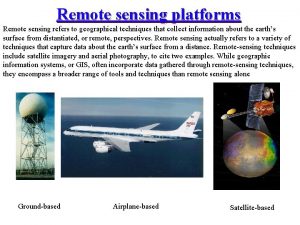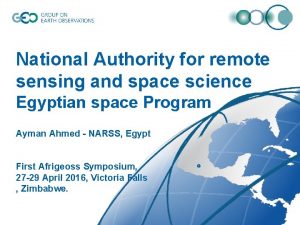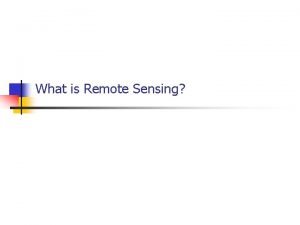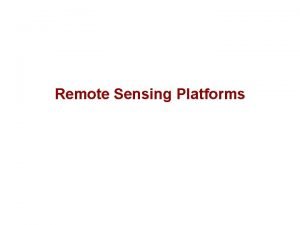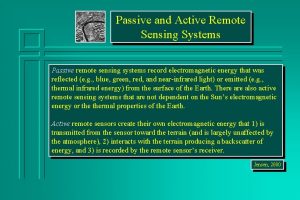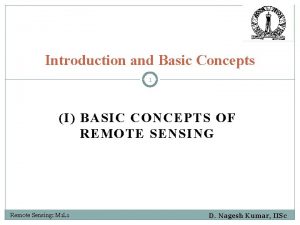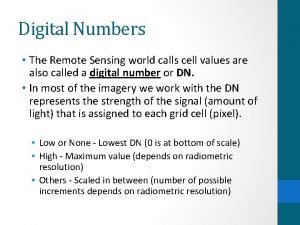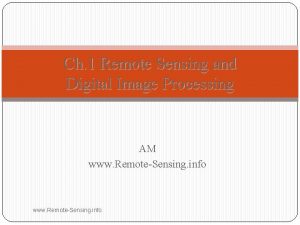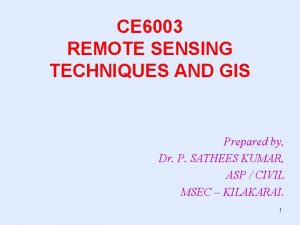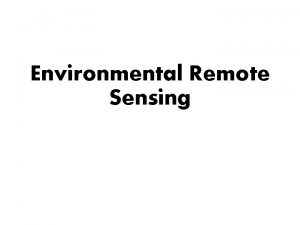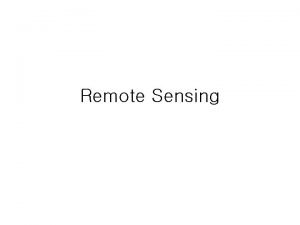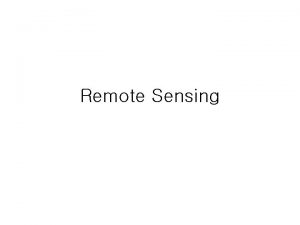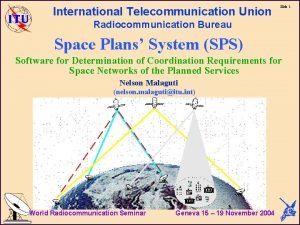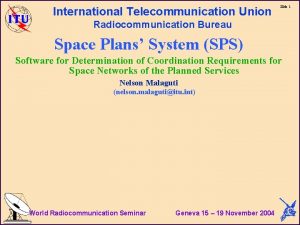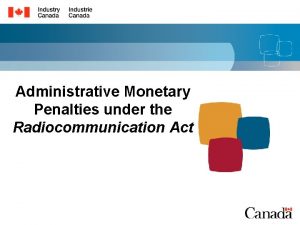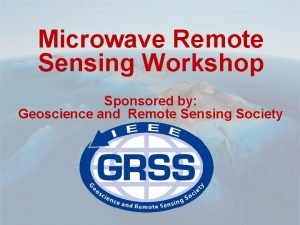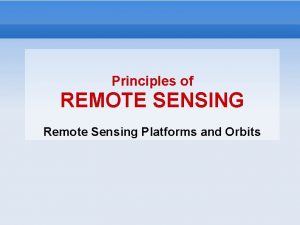International Telecommunication Union Radiocommunication Sector and Remote Sensing










- Slides: 10

International Telecommunication Union Radiocommunication Sector and Remote Sensing Valery TIMOFEEV Director of the Radiocommunication Bureau Workshop: “The Role of Remote Sensing in Disaster Management”, ITU, Geneva, 10 -11 December 2007 1

Radio and Sensors 1. 182 active sensor: A measuring instrument in the earth exploration-satellite service or in the space research service by means of which information is obtained by transmission and reception of radio waves. 1. 183 passive sensor: A measuring instrument in the earth exploration-satellite service or in the space research service by means of which information is obtained by reception of radio waves of natural origin. Article 1 of the Radio Regulations Workshop: “The Role of Remote Sensing in Disaster Management”, ITU, Geneva, 10 -11 December 2007 2

Remote Sensing in Disaster Management Remote sensors are the only tools that provide environmental data on a long term, repetitive and global scale. Radiocommunication systems based on remote sensing play the major role in weather and climate prediction. Remote sensing is the essential tool for disaster prediction, detection, disaster mitigation and planning of relief operations. Sensors are used for detection and tracking of earthquakes, tsunamis hurricanes, typhoons, floods, fires, oil leaks, dangerous pollution, etc. Workshop: “The Role of Remote Sensing in Disaster Management”, ITU, Geneva, 10 -11 December 2007 3

Radiocommunication Services and Remote Sensing Remote sensors are the basis of meteorological and Earth exploration-satellite services. • Operated in the main by government and international agencies. Data collected by active and passive sensors are distributed worldwide and used to benefit humanity as a whole. • Play a major role in prediction and detection of disasters (such as hurricanes, earthquakes and tsunamis, floods, fires, dangerous pollution, etc. ). • Remote sensing data are frequently disseminated through other radiocommunication systems belonging to the fixed-satellite service as well as other services. Workshop: “The Role of Remote Sensing in Disaster Management”, ITU, Geneva, 10 -11 December 2007 4

Global Observing System (GOS) Based on the use of sensors and dissemination of information by radio/telecommunication systems Workshop: “The Role of Remote Sensing in Disaster Management”, ITU, Geneva, 10 -11 December 2007 5

World Radiocommunication Conferences and Remote Sensing (1) Remote sensing requires several specific frequency ranges depending on the physical phenomena to be observed. WRCs regularly consider remote sensing requirements for allocation of additional frequency bands, sharing with other services, protection from interference, etc. E. g. WRC-07 considered (with positive results) 4 main issues directly related to remote sensing: • extension of band for active sensors; • extension of band for meteorological-satellite service; • sharing between Earth exploration-satellite service (EESS) (passive) and active services; • protection of EESS (passive) from unwanted emission from actives services. Workshop: “The Role of Remote Sensing in Disaster Management”, ITU, Geneva, 10 -11 December 2007 6

World Radiocommunication Conferences and Remote Sensing (2) WRC-07 also approved 5 Resolution and 4 Agenda items for the next WRC (WRC-11) on the use and further development of remote sensing systems: These Resolutions are related to: • use of optical links for remote sensing; • development of systems for lightning detection; • use of high-frequency oceanographic radars for measurement of coastal sea surface conditions; • further development of the meteorological-satellite systems operating near 8 GHz; • use of radiocommunications for Earth observation. Workshop: “The Role of Remote Sensing in Disaster Management”, ITU, Geneva, 10 -11 December 2007 7

Radiocommuncation Assembly 2007 (RA-07) RA-07 approved Resolution ITU-R 55 “ITU-R studies of disaster prediction, detection, mitigation and relief”. Res. ITU-R 55 identifies areas that ITU-R Study Groups could address in their studies/activities and develop guidelines related to the management of radiocommunication systems in disaster prediction, detection, mitigation and relief This is to be done collaboratively within & outside ITU to avoid duplication Workshop: “The Role of Remote Sensing in Disaster Management”, ITU, Geneva, 10 -11 December 2007 8

Studies by Radiocommunication Study Groups on Remote Sensing Radiocommunication Study Group 7 “Science services” is responsible for studies related to development and operation of Earth exploration and meteorological systems, which are based on remote sensing (active and passive) operating on both ground-based and space-based platforms. Other ITU-R Study Groups also develop ITU-R Recommendations, Reports and Handbooks related to sharing and protection of remote sensing from harmful interference by other radiocommunication services. Workshop: “The Role of Remote Sensing in Disaster Management”, ITU, Geneva, 10 -11 December 2007 9

A Sample of a Remote Sensing Application - Altimeter Mainly used for ocean and ice studies. Identifies a change of the sea level with precision of 2 to 3 cm See also ITU-R Web page at: http: //www. itu. int/ITUR/index. asp? category=information&link=emergency&lang=en Workshop: “The Role of Remote Sensing in Disaster Management”, ITU, Geneva, 10 -11 December 2007 10
 Ifov and fov in remote sensing
Ifov and fov in remote sensing National authority for remote sensing and space sciences
National authority for remote sensing and space sciences N-rays
N-rays Remote sensing platforms
Remote sensing platforms Active passive remote sensing
Active passive remote sensing Ideal remote sensing system
Ideal remote sensing system Digital number in remote sensing
Digital number in remote sensing Limitations of remote sensing
Limitations of remote sensing Idealized remote sensing system
Idealized remote sensing system Aggregation ap human geography
Aggregation ap human geography Remote sensing
Remote sensing
